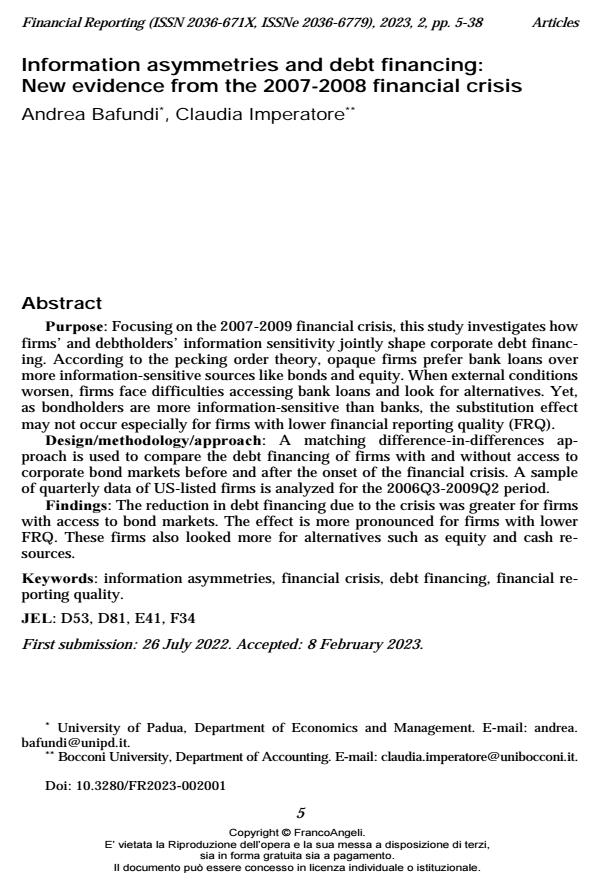Information asymmetries and debt financing: New evidence from the 2007-2008 financial crisis
Journal title FINANCIAL REPORTING
Author/s Andrea Bafundi, Claudia Imperatore
Publishing Year 2023 Issue 2023/2
Language English Pages 34 P. 5-38 File size 221 KB
DOI 10.3280/FR2023-002001
DOI is like a bar code for intellectual property: to have more infomation
click here
Below, you can see the article first page
If you want to buy this article in PDF format, you can do it, following the instructions to buy download credits

FrancoAngeli is member of Publishers International Linking Association, Inc (PILA), a not-for-profit association which run the CrossRef service enabling links to and from online scholarly content.
Purpose: Focusing on the 2007-2009 financial crisis, this study investigates how firms’ and debtholders’ information sensitivity jointly shape corporate debt financing. According to the pecking order theory, opaque firms prefer bank loans over more information-sensitive sources like bonds and equity. When external conditions worsen, firms face difficulties accessing bank loans and look for alter-natives. Yet, as bondholders are more information-sensitive than banks, the substi-tution effect may not occur especially for firms with lower financial reporting qual-ity (FRQ). Design/methodology/approach: A matching difference-in-differences ap-proach is used to compare the debt financing of firms with and without access to corporate bond markets before and after the onset of the financial crisis. A sample of quarterly data of US-listed firms is analyzed for the 2006Q3-2009Q2 period. Findings: The reduction in debt financing due to the crisis was greater for firms with access to bond markets. The effect is more pronounced for firms with lower FRQ. These firms also looked more for alternatives such as equity and cash re-sources.
Keywords: information asymmetries, financial crisis, debt financing, financial re-porting quality.
Jel codes: D53, D81, E41, F34
- The dynamics of cost behavior: Unveiling sticky costs in private companies Nicola Dalla Via, in FINANCIAL REPORTING 2/2024 pp.13
DOI: 10.3280/FR2024-002002 - Does leverage create or destroy value in the long run? A re-examination of Nissim and Penman (2001) Antonio De Vito, Lorenzo Dal Maso, Patrizia Petrolati, Noemi Pecoraro, in FINANCIAL REPORTING 2/2024 pp.47
DOI: 10.3280/FR2024-002003
Andrea Bafundi, Claudia Imperatore, Information asymmetries and debt financing: New evidence from the 2007-2008 financial crisis in "FINANCIAL REPORTING" 2/2023, pp 5-38, DOI: 10.3280/FR2023-002001